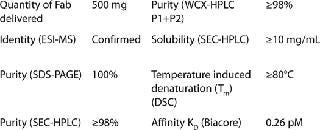Expression of a Fab Fragment in Pfēnex Expression Technology™
August 1, 2011

The Pfēnex Expression Technology™ platform is a powerful protein Expression Technology based on the novel host Pseudomonas fluorescens. Legacy recombinant protein expression hosts such as E. coli and yeast tend to have high failure rates with regard to expression of soluble, active protein. In addition, the time required to identify the optimal expression strain in these systems is protracted, resulting in significant opportunity cost for drug developers. Leveraging the Pfēnex Expression Technology™ shortens development time via higher success rates and lowers overall cost of goods associated with rapid process cycle times, high cell densities, and low-cost media.
Overview: Tables 1 and 2 are based on a case study presented by Georg Klima, head of microbial process science at Boehringer Ingelheim. It outlines the expression of a Fab fragment through four different approaches including E. coli (periplasmic), E. coli (inclusion body), Pichia pastoris, and Pseudomonas fluorescens (Pfēnex Expression Technology™). Results of the study reveal that Pfēnex was successful not only in delivering 500 mg of soluble, active, high-quality, highly purified protein for preclinical evaluation, but it was able to do so within 10 weeks of receipt of the optimized gene. All three other expression approaches failed to express the protein.
Table 1: Expression host results

Table 1: Expression host results ()
Table 2: Analytical Results of the P. fluorescens (Pfenex Expression Technology™) Expressed Fab

Table 2: Analytical Results of the P. fluorescens (Pfenex Expression Technology™) Expressed Fab ()
The Pfēnex Expression Technology™ platform offers a robust solution to the real and opportunity costs incurred through the maintenance of several recombinant expression platforms. The value to drug developers is clear: There are significant opportunity and real costs associated with using the traditional linear and iterative approach to strain engineering. Indeed, data derived from other expression systems suggest development program delays in the range of five to 12 months on programs that have used such a serial approach. The real costs of such delays, including materials, FTEs, and facility costs are in the millions of dollars and certainly millions of dollars more due to the delays of a product reaching commercialization stage. As a result, using a platform such as Pfēnex Expression Technology™ in discovery and throughout the development program provides tangible benefits not only in expediting programs by efficient protein production, but also by allowing programs to avoid attrition due to inability to produce material.
About the Author
Author Details
Cassidy Brady is marketing manager at Pfenex Inc.,10790 Roselle Street, San Diego CA 92121; [email protected]; www.pfenex.com.
REFERENCES
1.) Klima, G. 2011. Expression of an Antibody Fragment Utilizing the Pfenex Expression Technology Platform, PEGS 2011, Boston.
You May Also Like





